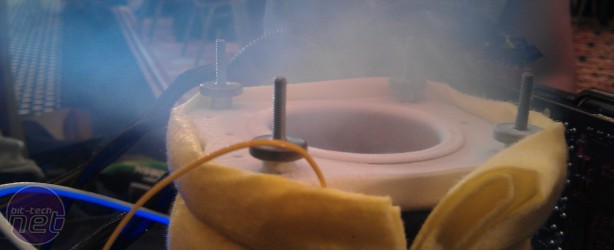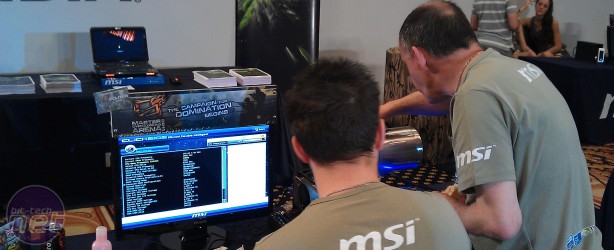
How to Get Into Sub-Zero Cooling
bit-tech: So what advice would you give to a bit-tech reader who is either on HWBOT and wants to improve their rank, or is just a casual overclocker who likes the idea of messing around with sub-zero cooling? How could they go about getting to events such as this in the next few years?Eddie Coyle: Well, to get to events like this you do need experience with sub-zero cooling, be it phase change, dry ice or LN2, because running CPUs at sub-zero temperatures is really very different to running them under air or water. It’s a lot more extreme and there are many more factors to consider. It can also be quite expensive, as dry ice isn’t cheap and you can only get LN2 by agreeing a contract with a supplier that won’t give it to you in small quantities.
Tom Rawes: The easiest way to get into this kind of thing is via dry ice, without a doubt. You can get yourself a cheap aluminium pot, which should cost somewhere around about £70. You can then get yourself some dry ice (you’ll need around 10kg), which will cost about £35 and you’ve got yourself a good weekend there. It would be worth looking up some tips on how to insulate the board, but that doesn’t take long.
Once you’re used to that, you can then save up for a better pot to help you get your temperatures even lower and hopefully an even better score. Then, when you’re used to the -70oC temperature you can get from dry ice, you can try to get some LN2, which can take you down to -185oC. If you enjoy all that, then you could even try and get some liquid helium which goes down to about -230oC or something.
BT: Is there actually a benefit to dropping the temperature down that low?
TR: Well, the only guys who use liquid helium are the guys looking to break the all time CPU-Z record, so it’s not something you see that often. It’s at 8.4GHz at the moment and that was on liquid helium. You have to actually ‘warm up’ the pot with LN2 first before moving on to it. It’s quite dangerous to use and very hard to monitor, so you can hit a lot of cold boot problems with it. Bear in mind too that another guy who got 8.3GHz did it on LN2, so I don’t think liquid helium offers that much more. It’s a super-competitive area though, so everyone is looking for any advantage they can get.
BT: We see a lot of motherboards come through the bit-tech labs that are apparently aimed at extreme overclockers and those looking to set benchmark records, and they're invariably very expensive. Do you need one of these boards to compete and if you do, how can you afford it?
EC: Well, sometimes you get lucky and pick up a board from an event like this one, but I would never normally be able to afford something of this cost - they’re too expensive. There are younger members of our forums that aren’t married with kids, and they can probably afford them though. You also tend to find that a lot of them are given to enthusiasts to test and give feedback on.
TR: Well I’d have to hold my hands up and say that I can occasionally afford a shiny uber-expensive board, and I’ll buy it and then sell it on after a few weeks. It’s quite common to get hold of a top-end board to play with, benchmark and see what it can do, and then sell it on. There is always someone who’ll want the board for less than it costs in the shops.
BT: Do you guys train for events like this? Is overclocking something that you need to practice on a regular basis to remain competitive?
TR: I certainly practice at home. They sent us out the kit early too, so I was able to get used to it and get to know what it could do. What I tend to focus on, though, is speed and efficiency. I’ll set myself a two-hour time limit and make a note of all the tweaks I can get done in that time so I know how long it will take me. It’s a case of trying to put myself in that situation with the time pressure that you get in events like these, so I can try and get used to it. The best overclockers are those who can get a great score out of a piece of hardware in a given time limit. Yes, someone else could probably get something better after a week of tweaking and testing, but I think they’d struggle in a situation like this.
EC: I experimented with dry ice for two weeks before this competition specifically to practice for it. Unfortunately, I didn’t have the motherboard to play with, as that was with Tom, but it’s still good to practice to get used to how much voltage certain chips want and things like that. It’s good just to get used to dealing with sub-zero cooling, and dealing with the sort of problems that can arise at such temperatures.

MSI MPG Velox 100R Chassis Review
October 14 2021 | 15:04










Want to comment? Please log in.